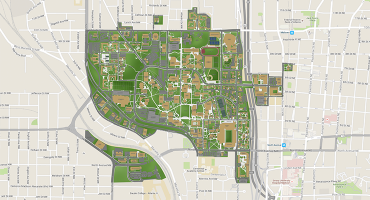Networks can be found everywhere: in our daily social exchanges, the food webs that connect every living thing on Earth, and the interactions between proteins in the living body. From the global scale to the cellular level, they are a way of mapping and understanding the interactions within and between systems.
While many connections are immediately apparent in a network, these systems also contain a large amount of hidden information. For example, a social network might connect the last 15 people you interacted with, but hidden in that network could be information about age, ethnicity, location, and more.
“When scientists are given a network, their interest is typically to extract some information or structure hidden in the network,” Cheng Mao, an assistant professor in the School of Mathematics, explains.
To do so, scientists engage in network analysis, leveraging mathematics and statistics. Now, a new $450,000 NSF CAREER grant will help Mao research and develop new mathematical methods and models to facilitate this work.
The National Science Foundation Faculty Early Career Development Award is a five-year grant designed to help promising researchers establish a foundation for a lifetime of leadership in their field. Known as CAREER awards, the grants are NSF’s most prestigious funding for untenured assistant professors.
The award, for “Statistical Inference on Random Graphs and Hypergraphs: Geometry, Combinatorics, and Computation” will also support Mao as he integrates the research into his teaching, with an emphasis on supporting students from diverse backgrounds. “I taught a topics course on Statistical Inference on Random Graphs at Georgia Tech and look forward to further developing the course,” he adds. “I aim to expand the lecture notes into a long-form text that can be used by students and junior researchers interested in this area.”
Reading between the lines
“Statistics are playing an increasingly significant role in network analysis by providing a toolbox for extracting information from noisy network data.” Mao explains. “This project aims to develop statistical models and computational methods for uncovering such hidden information so that we can make sense of large complex networks.”
Imagine a network of researchers, where each person is represented as a dot on a page — a node on a graph, in mathematical terms. Every researcher who has co-authored a paper might be connected with a line, creating a web, or network of collaborators. And while this graph does immediately convey some information, additional information is hidden within it.
“What information is hidden in this network?” Mao asks. “One example is the geographic locations of these researchers. Researchers based in the same institution or the same country may collaborate more often, so there may be more links between them in the network.” This is where Mao’s research comes in.
Using tools from statistics and information theory, Mao aims to leverage mathematical models to characterize these connections in order to decode them — and reveal information that might not be immediately available. “This part of research is closely connected to the areas of theoretical computer science and machine learning, where a major task is to develop fast algorithms and then rigorously analyze their performance,” he explains.
Mathematics, and beyond
Mao underscores the intersectionality of his research: networks are studied by economists and ecologists, psychologists, and mathematicians. “It is common that researchers in different scientific and engineering fields study a similar problem but develop their own ways to solve it,” he says, adding that “we aim to widely disseminate the research results to statisticians, computer scientists, and any researchers who study or use network analysis.” He hopes the research can facilitate the analysis of social and biological networks, leading to discoveries and innovations across many fields.
In turn, these real-word applications could lead to theoretical breakthroughs on the mathematical side of things. “While mathematical research can evolve on its own, real-world problems can also provide guidance for developing theoretical mathematics,” Mao explains. “So our goal is to make this research impactful for everyone — both theorists and practitioners.”
School of Physics Assistant Professor Zeb Rocklin has also been awarded a CAREER grant for his research on flexible metamaterials and deformable solids. Read “Smart Solids: Zeb Rocklin Awarded NSF CAREER for Flexible Metamaterials Research” to learn more.
For More Information Contact
Written by Selena Langner




